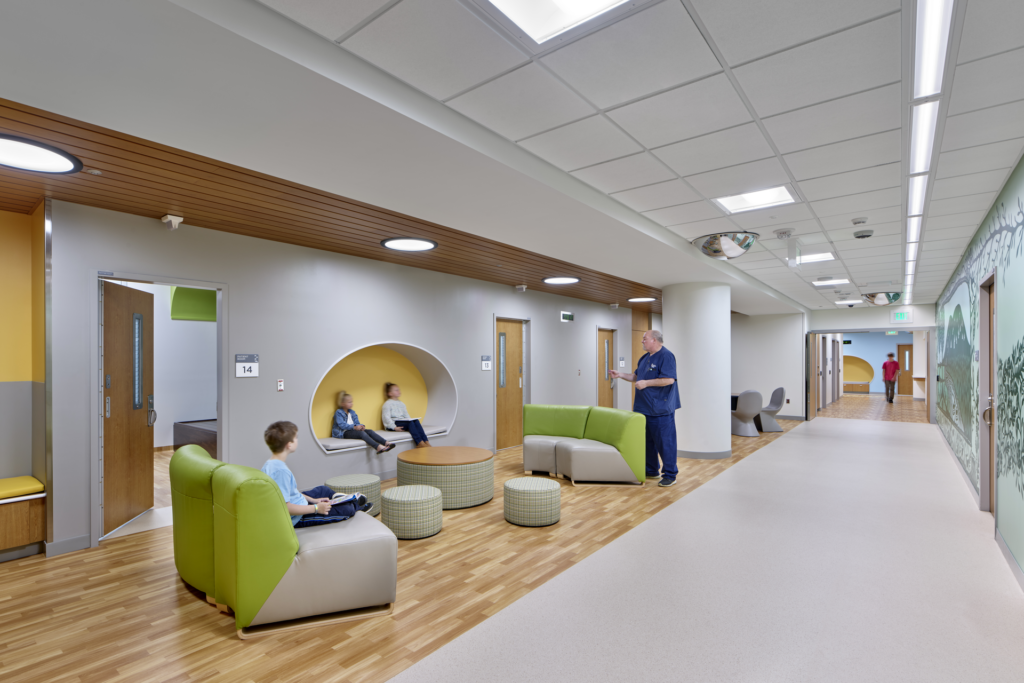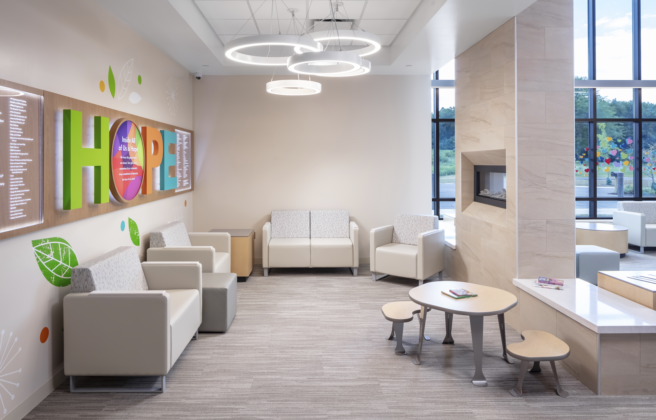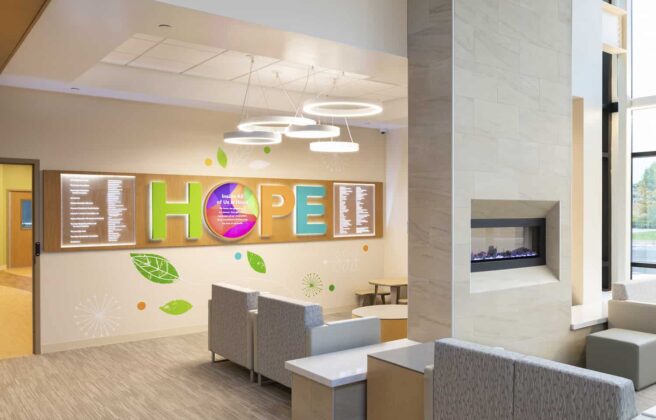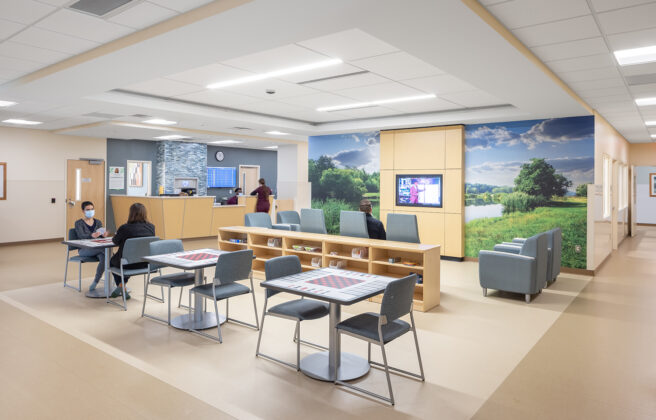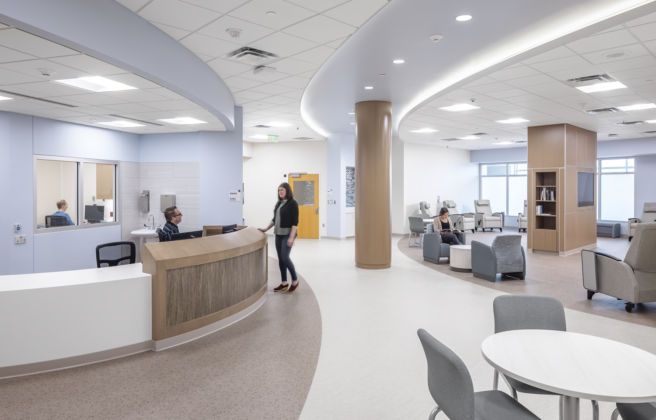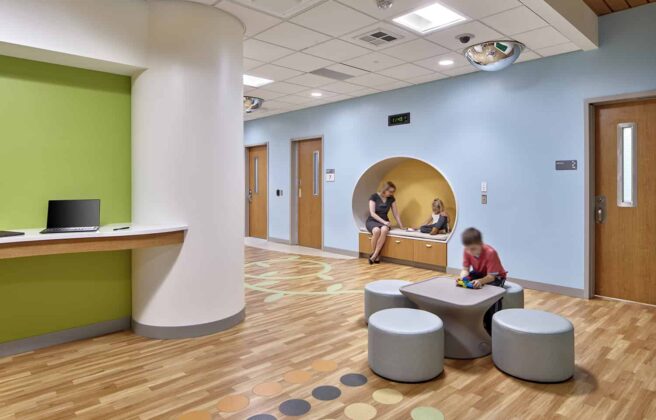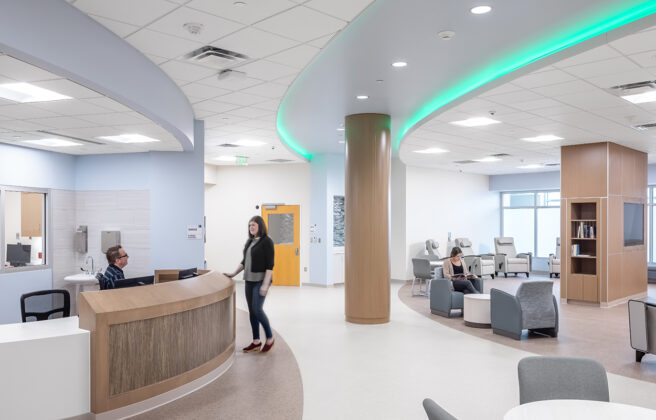Like any other healthcare facility, behavioral health environments must be comforting places to heal. But these spaces pose unique considerations to keep patients safe, requiring thoughtful balance from skilled design professionals to create environments that are beautiful and manage patient risk. Senior Interior Designer Lauren Frank, Senior Project Manager Susan Golberg, and Senior Architect Ellen Konerza are a few members of the BWBR team who work to design these facilities, and in the latest episode of Side of Design, they dive in to creating environments that prioritize safety without feeling cold or institutional.
Evaluating Risk
Behavioral health facilities are complex environments, with many different factors to consider – balancing safety guidelines and aesthetics, customizing layouts to facilitate staff operations, and evaluating the potential risks in any given space. One important tool to help designers manage the complexities is the Behavioral Health Design Guide, a living document that classifies different areas of a facility from 1 (lowest risk) to 5 (highest risk). “[The Guide] represents the leading current industry practices for these environments, and it’s a practical means for designers to make sure the spaces are protecting the patients and the staff from harm,” explains Ellen. The guidelines are informed by organizations like the Facility Guidelines Institute (FGI) and Veteran’s Affairs (VA) to address the built environment for adult inpatient behavioral health units.
Level one areas are not accessible by patients, such as staff breakrooms, where standard fixtures are acceptable. Level two encompasses rooms with heavy staff supervision, while level three is considered the baseline for most patient areas – lounges, dining areas, and other areas that are open, visible, and have less intensive supervision fall under this level. Rooms where a patient can be alone, like bedrooms and bathrooms, are considered level four, and the highest level is seen in spaces where patients may be experiencing high stress or agitation, such as intake areas or seclusion rooms.
“These levels guide everything from ceiling heights to furniture choices,” says Susan. Ligature resistance is one of the biggest factors in behavioral health design, but elements like acoustical treatments, spatial density, and clear wayfinding also contribute to safety and risk.
Customized Criteria
While an extremely important tool for designers, these guidelines aren’t hard-and-fast rules – they’re a baseline to be customized to the unique needs of each client and their patient population. Since the criteria only address general adult units, different age groups and treatment specializations may have more or less intensive needs than what is outlined in the guide. Staff may also employ risk mitigation strategies in their operations that reduce certain design needs. “The only way to hear about those risks is from the staff who work with the patients in that unit. So, their voices are really important in every decision,” says Ellen.
Potential risks to child and adolescent patients vary greatly from risks to adult or geriatric patients. “For instance, you can imagine someone younger running down a long hallway and with the ceiling height – if it’s just nine feet– it’s easy to jump and pop that ceiling tile up,” Ellen explains. “Geriatric patients probably wouldn’t be popping those ceiling tiles up.” Every decision matters, and it’s critical that each design element is selected thoughtfully and strategically.
Particularly for facilities receiving reimbursements for Medicare or Medicaid, requiring surveys by the Joint Commission, documentation of risk mitigation is crucial: “It’s a good diagrammatical tool to be able to say these are the different spaces, and these are the risk levels based on how the clients have described their patients using the unit,” says Lauren. “If the Joint Commission comes, they have a diagram and document to back up why decisions were made and why room types are designed the way they are.”
Going Beyond the Baseline
With the need for secure, ligature-resistant environments, one of the biggest challenges in behavioral health design is creating a safe space without feeling institutional or punitive.
“We need to be creating a therapeutic healing environment. We don’t want to have the space defeat the patient before they walk in,” says Susan. “It’s a balancing act. We’ll never be able to get any place risk-free but we do want to try to reduce risk.”
This balance extends to every aspect of design, from the overall layout to the smallest details. Sometimes, modifying the criteria is worth the reward. Susan provides an example of selecting lay-in ceilings rather than hard-lid ceilings, which are typically recommended at heights under ten feet due to ligature risk. Tiled lay-in ceilings, though, offer better acoustics. In a case such as a group therapy room with ceilings under ten feet, “staff may decide it’s more important that they have the acoustics for the therapeutic elements of the space, and the space is supervised so they’ll take on that risk,” she explains.
Lauren points out the importance of making spaces “home-like and calming, bringing nature in so that it feels welcoming, inviting… like a place where you could get better.” The designers utilize Human-Centered Safety, BWBR’s holistic, integrated design approach to behavioral spaces where safety is priority, but not at the expense of patient dignity and choice. The result is environments where families can feel confident and comfortable bringing a loved one to, and where patients feel welcomed and safe upon arrival.
An Ever-Evolving Field
The field of behavioral health design is constantly evolving, driven by new research, changing standards, and product innovations. Lauren highlights the New York State Office of Mental Health guide, which is regularly updated with new product evaluations.
“Different vendors are constantly coming up with new ligature-resistant products that we can then bring to our clients to have them test and provide feedback on,” Lauren explains. These first-hand accounts allow the team to apply valuable experience to new projects, bringing solutions that have been tried and tested in similar environments.
The team also discusses how, as research continues, new safety concerns can be discovered in products that were previously recommended by guides. Replacing these products may be costly, but ultimately improves patient safety by eliminating known risks. Because of the fast-paced innovations in behavioral health spaces, it’s all the more important that BWBR team members stay on top of the latest recommendations for risk mitigation. This way, they can help clients make strategic, informed decisions to reduce major costs and construction down the road.
In the end, the goal is to create spaces that do more than meet the minimum requirements for safety. By blending deep understanding of risks with compassionate design, behavioral health environments can be truly therapeutic and healing environments, making a lasting impact for patients and their families while allowing staff to deliver effective care.


